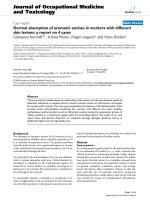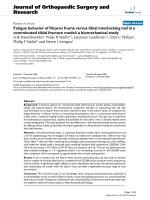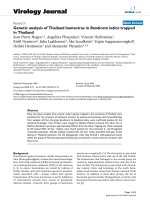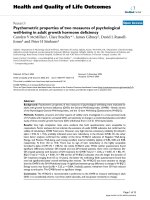báo cáo hóa học:" Growth behavior of titanium dioxide thin films at different precursor temperatures" pptx
Bạn đang xem bản rút gọn của tài liệu. Xem và tải ngay bản đầy đủ của tài liệu tại đây (654.83 KB, 12 trang )
This Provisional PDF corresponds to the article as it appeared upon acceptance. Fully formatted
PDF and full text (HTML) versions will be made available soon.
Growth behavior of titanium dioxide thin films at different precursor
temperatures
Nanoscale Research Letters 2012, 7:89 doi:10.1186/1556-276X-7-89
Sang-Hun Nam ()
Sang-Jin Cho ()
Jin-Hyo Boo ()
ISSN 1556-276X
Article type Nano Express
Submission date 9 September 2011
Acceptance date 26 January 2012
Publication date 26 January 2012
Article URL />This peer-reviewed article was published immediately upon acceptance. It can be downloaded,
printed and distributed freely for any purposes (see copyright notice below).
Articles in Nanoscale Research Letters are listed in PubMed and archived at PubMed Central.
For information about publishing your research in Nanoscale Research Letters go to
/>For information about other SpringerOpen publications go to
Nanoscale Research Letters
© 2012 Nam et al. ; licensee Springer.
This is an open access article distributed under the terms of the Creative Commons Attribution License ( />which permits unrestricted use, distribution, and reproduction in any medium, provided the original work is properly cited.
Growth behavior of titanium dioxide thin films at different precursor
temperatures
Sang-Hun Nam*
1
, Sang-Jin Cho
1
, and Jin-Hyo Boo*
1
1
Department of Chemistry and Institute of Basic Science, Sungkyunkwan University, Suwon,
440-746, South Korea
*Corresponding authors: ;
Email addresses:
S-HN:
S-JC:
J-HB:
Abstract
The hydrophilic TiO
2
films were successfully deposited on slide glass substrates using
titanium tetraisopropoxide as a single precursor without carriers or bubbling gases by a
metal-organic chemical vapor deposition method. The TiO
2
films were employed by scanning
electron microscopy, Fourier transform infrared spectrometry, UV-Visible [UV-Vis]
spectroscopy, X-ray diffraction, contact angle measurement, and atomic force microscopy.
The temperature of the substrate was 500°C, and the temperatures of the precursor were kept
at 75°C (sample A) and 60°C (sample B) during the TiO
2
film growth. The TiO
2
films were
characterized by contact angle measurement and UV-Vis spectroscopy. Sample B has a very
low contact angle of almost zero due to a superhydrophilic TiO
2
surface, and transmittance is
76.85% at the range of 400 to 700 nm, so this condition is very optimal for hydrophilic TiO
2
film deposition. However, when the temperature of the precursor is lower than 50°C or higher
than 75°C, TiO
2
could not be deposited on the substrate and a cloudy TiO
2
film was formed
due to the increase of surface roughness, respectively.
Keywords: TiO2; superhydrophilic; precursor temperature; anatase phase; growth behavior.
Introduction
Since a TiO
2
film showing a high refractive index is transparent in the visible light range, it
can be used as an antireflection coating on a SiO
2
thin film [1]. It can also act as a
photocatalyst because of its chemical stability, high quantum yield, and nontoxic property [2].
For all of these optical applications, it is necessary to control polymorphs of TiO
2
, which
have different structural and optical properties. It is well known that TiO
2
exists in three
different polymorphs: rutile, anatase, and brookite [2]. To our knowledge, brookite is an
orthorhombic structure and has not been observed in thin films. Both rutile and anatase phase
are tetragonal structures. The anatase phase is a low-temperature polymorph with a less dense
structure (3.894 g/cm
3
) [2], an optical bandgap of 3.25 eV [3, 4, 5], and a refractive index of
2.5 [6]. TiO
2
has been attracting much interest due to a wide range of applications such as in
dye-sensitized solar cells [7, 8], photocatalysts [9-12], optical coatings [6], and capacitors for
large-scale integrated devices [13]. TiO
2
photocatalysts have been applied in various fields, in
which the anti-fogging, self-cleaning, or automobile windows should be quite attractive. The
photocatalytic activities of TiO
2
materials strongly depend on surface morphology, crystal
structure, and crystallization of the concerned TiO
2
photocatalyst. Various deposition
techniques have been developed for depositing TiO
2
thin films, including evaporation [3],
sputtering [14], thermal oxidation of titanium [4], and the chemical vapor deposition [CVD]
method [15]. Among them, the CVD technique using a metal-organic compound as a
precursor [MOCVD] has many advantages, such as a good conformal coverage, the
possibility of epitaxial growth and selective deposition, and the application to large-area
deposition. Also, this method is of low cost, and it is easy to control the deposition growth
parameters. Thus, the MOCVD method is well known as one of the most powerful techniques
and is suitable for stoichiometric and microstructural thin film deposition [16].
In this experiment, therefore, we deposited TiO
2
thin films on glass substrates with a single
molecular precursor as titanium tetraisopropoxide at different precursor temperatures such as
75°C (sample A) and 60°C (sample B) by the MOCVD method. Also, we discuss the
influence of the precursor temperature on the surface energy of TiO
2
thin films.
Experimental details
TiO
2
thin films were deposited on a glass substrate using a MOCVD reactor, whose system
was fabricated using a quartz tube and stainless steel bodies connected through O-ring joints.
The MOCVD apparatus was evacuated using a rotary pump. The glass substrate was
pretreated with acetone, ethanol, and deionized water in an ultrasonic cleaner and mounted
onto the graphite holder that was laid in the center of the MOCVD chamber. To fix the glass
substrate onto the graphite holder tightly, we grooved the graphite holder and tilted it at an
angle to get a thin film with a uniform surface. The graphite holder was heated using a DC
power through a super-Kanthal wire (Sandvik Korea Ltd., Seoul, South Korea) inserted in it
with a substrate temperature at 400°C. The general deposition conditions are a temperature of
400°C, a working pressure of 8.2 × 10
−2
Torr, and a working time of 30 min. Titanium
tetraisopropoxide (Ti[OCH(CH
3
)
2
]
4
) [TTIP] was used as a precursor with heating at 60°C and
75°C and without a bubbler gas. The as-grown films were characterized with X-ray
diffraction [XRD], scanning electron microscopy [SEM], atomic force microscopy [AFM],
Fourier transform infrared spectrometry [FT-IR], contact angle measurement, and ultraviolet-
visible [UV-Vis] spectroscopy.
Results and discussion
The structures of TiO
2
thin films were characterized by XRD using Cu Kα radiation at 30 kV
and 40 mA. Figure 1 shows the XRD patterns of the TiO
2
thin films as a function of the
precursor temperature. All the TiO
2
thin films were deposited on the glass substrate at 400°C.
Sample A showed the anatase phase and the randomly oriented polycrystalline structure.
Several peaks are observed for sample A thin films at a precursor temperature of 75°C such
as (101), (200), (211), and (220). On the other hand, there is no peak for sample B thin films
at a precursor temperature of 60°C, indicating that the thin film is amorphous. It has been
reported that the onset temperature of the thermally activated transformation from an
amorphous to an anatase phase was dependent on experimental parameters such as deposition
methods, deposition temperature, and different substrates. In this present work, the
amorphous phase of the TiO
2
thin films on the glass substrate at 400°C exists up to the
precursor temperature of 60°C. The anatase phase appears at a precursor temperature of 75°C.
The influence of the precursor temperature is evidenced in the case of deposition on the glass
in Figure 2a,b,c,d. The surface is composed of grains, the size of which decreases with the
precursor temperature: it is about 50 nm for a growth at 75°C. In the case of a growth at a
precursor temperature of 60°C, clusters of about 100 nm appear, resulting in a rougher
surface. The SEM images show that the TiO
2
grown layers have a columnar shape. The
columnar structure can be evidenced by SEM images taken on cut edges perpendicular to the
growth direction. Sample A has a denser surface than sample B. This phenomenon can be
explained by precursor nucleation, above the substrate, the clusters being then adsorbed on
the surface.
Figure 3 shows AFM images of the TiO
2
thin films with different precursor temperatures such
as 75°C (sample A) and 60°C (sample B). Sample A showed the flattest surface among these
films. On the other hand, sample B exhibited more rough surfaces than sample A. The surface
roughness values obtained by AFM for these films were 4.85 and 5.51 nm for A and B,
respectively. The thickness of these films was about 300 nm. The slight change of surface
roughness might result from two factors such as the limited surface diffusion caused by
relatively low thermal energy and a crystallite size effect; nevertheless, our samples have
similar surface roughness. This means that a change of the precursor temperature does not
influence the surface roughness of TiO
2
thin films.
FT-IR spectra of the TiO
2
thin films in Figure 4 show that peaks corresponding to stretching
vibrations of O-H and C=O are around 3,300 to 3,500 and 1,600 to 1,700 cm
−1
, respectively.
Also, the peak around 500 to 1,000 cm
−1
should be assigned to the stretching vibration of Ti-
O and Ti-O-Ti. In the case of sample B, the intensity of the O-H stretching peak was
increasing more than that of sample A. This means that sample B has more high surface
energy than sample A.
Figure 5 shows the UV-Vis spectrum of deposited TiO
2
thin films at different precursor
temperatures such as 75°C (sample A) and 60°C (sample B). The TiO
2
thin film was fast
deposited at the sample A condition (precursor temperature at 75°C). This condition appeared
as a haze effect and it has low transmittance. On the other case (sample B; precursor
temperature at 60°C), the TiO
2
thin film had a transmittance of about 70%.
Figure 6a,b shows the water contact angle with a change from being hydrophobic to being
superhydrophilic at a precursor temperature of 75°C to 60°C. Sample A surface was observed
to be hydrophobic with a contact angle of 46°. On the other hand, sample B surface was
superhydrophilic between 0° and 5° at a 60°C heating treatment. There are various reasons of
the change in the water contact angle, but we are convinced that the primary factor of the
precursor heating treatment is the surface functional group. Therefore, SEM and XRD were
employed for the confirmation of changed roughness, and FT-IR analysis was performed for
the verification of changed O-H surface functional group. At the precursor temperature of
60°C, the thin film was grown in the amorphous phase and has an increasing coordination
number. This means that it has a surface energy which is higher than that of the crystalline
thin film. Therefore, sample B has a superhydrophilic surface.
Conclusions
The hydrophilic TiO
2
films were successfully deposited on slide glass substrates using TTIP
as a single precursor without carriers or bubbling gases by the MOCVD method. The
amorphous phase of the TiO
2
thin films on the glass substrate at 400°C exists up to the
precursor temperature of 60°C. The anatase phase appears at a precursor temperature of 75°C.
The columnar structure can be evidenced by SEM images taken on cut edges perpendicular to
the growth direction. Sample A has a denser surface than sample B. This phenomenon can be
explained by precursor nucleation, above the substrate, the clusters being then adsorbed on
the surface. XRD data show that the phase was diverted from amorphous to anatase, and FT-
IR analysis was performed for the verification of changed O-H surface functional group. At
the precursor temperature of 60°C, the thin film was grown in the amorphous phase and has
an increasing coordination number.
Competing interests
The authors declare that they have no competing interests.
Authors' contributions
S-HN and J-HB conceived the study. S-HN carried out the experiments. S-JC contributed the
analysis of the study. S-HN drafted the manuscript. All authors are involved in revising the
manuscript and approved the final version.
Acknowledgments
This research was supported by grants NRF-20100029417 (SRC Program of Center for
Plasma Bioscience Research) and NRF-20100029699 (Priority Research Centers Program).
References
1. Martinet C, Paillard V, Gagnaire A, Joseph J: Deposition of SiO
2
and TiO
2
thin films by
plasma enhanced chemical vapor deposition for antireflection coating. J Non-Cryst
Solids 1997, 216:77.
2. Linsebigler AL, Lu G, Yates JT Jr: Photocatalysis on TiO
2
surfaces: principles,
mechanisms, and selected results. Chem Rev 1995, 95:735.
3. Tang H, Prasad K, Sanjines R, Schmid PE, Levy F: Electrical and optical properties of
TiO
2
anatase thin films. J Appl Phys 1994, 75:2042.
4. Daude N, Gout C, Jouanin C: Electronic band structure of titanium dioxide. Phys Rev B
1977, 15:3229.
5. Brady GS: Materials Handbook. New York: McGraw-Hill; 1971.
6. Boschloo GK, Goossens A, Schoonman J: Photoelectrochemical study of thin anatase
TiO
2
films prepared by metallorganic chemical vapor deposition. J Electrochem Soc
1997, 144:1311.
7. O’Regan B, Gratzel M: A low-cost, high-efficiency solar cell based on dye-sensitized
colloidal TiO
2
films. Nature (London) 1991, 353:737.
8. Hagfelt A, Gratznel M: Light-induced redox reactions in nanocrystalline systems.
Chem Rev 1995, 95:49.
9. Fujishima A, Honda K: Electrochemical photolysis of water at a semiconductor
electrode. Nature 1972, 238:37.
10. Fujishima A, Honda K: Electrochemical evidence for the mechanism of the primary
stage of photosynthesis. Bull Chem Soc Jpn 1971, 44:1148.
11. Kawai T, Sakata T: Conversion of carbohydrate into hydrogen fuel by a photocatalytic
process. Nature 1980, 286:474.
12. Wang R, Hashimoto K, Fujishima A, Chikuni M, Kojima E, Kitamura A, Shimohigoshi M,
Watanabe T: Light-induced amphiphilic surfaces. Nature 1997, 388:431.
13. Lee YH: A role of energetic ions in RF-biased PECVD of TiO
2
. Vacuum 1998, 51:503.
14. Yoshimura K, Mike T, Tanemura S: Plasma luminescence generated in laser
evaporation of dielectrics. J Vac Sci Technol A 1997, 5:15.
15. Zhang Q, Griffin GL: Gas-phase kinetics for TiO
2
CVD: hot-wall reactor results. Thin
Solid Films 1995, 263:65.
16. Kim EK, Son MH, Min S-K, Han YK, Yom SS: Growth of highly oriented TiO
2
thin
films on InP (100) substrates by metalorganic chemical vapor deposition. J Cryst
Growth 1997, 170:803.
Figure 1. XRD patterns of the TiO
2
thin films at different precursor temperatures.
Sample A at 75°C and sample B at 60°C.
Figure 2. SEM images of the TiO2 thin films at different precursor temperatures. (a)
Morphology and (b) cross section of sample A at 75°C and (c) morphology and (d) cross
section of sample B at 60°C.
Figure 3. AFM images of the TiO
2
thin films at different precursor temperatures. (a)
Sample A at 75°C and (b) sample B at 60°C.
Figure 4. FT-IR spectra of the TiO
2
thin films at different precursor temperatures. (a)
Sample A at 75°C and (b) sample B at 60°C.
Figure 5. UV-Vis spectra of the TiO
2
thin films at different precursor temperatures. (a)
Sample A at 75°C and (b) sample B at 60°C.
Figure 6. Water contact angle images of the TiO
2
thin films at different precursor
temperatures. (a) Sample A at 75°C and (b) sample B at 60°C.
Figure 1
Figure 2
Figure 3
Figure 4
Figure 5
Figure 6









